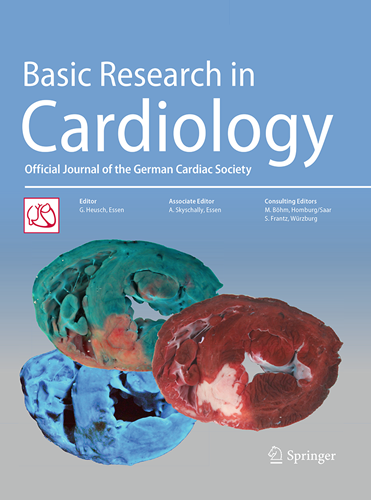The innate immune receptor NLRX1 is a novel required modulator for mPTP opening: implications for cardioprotection.
IF 8
1区 医学
Q1 CARDIAC & CARDIOVASCULAR SYSTEMS
引用次数: 0
Abstract
NLRX1 is the only NOD-like innate immune receptor that localises to mitochondria. We previously demonstrated that NLRX1 deletion increased infarct size in isolated mouse hearts subjected to ischemia-reperfusion injury (IRI); however, underlying mechanisms are yet to be identified. Given the crucial role played by mitochondria in cardiac IRI, we here hypothesise that NLRX1 affects key mechanisms of cardiac IRI. Cardiac IRI was evaluated in isolated C57BL/6J (WT) and NLRX1 knock out (KO) mouse hearts. The following known modulators of IRI were explored in isolated hearts, isolated mitochondria; or permeabilised cardiac fibres: 1) mTOR/RISK/autophagy regulation, 2) AMPK and mitochondrial energy production, and 3) mitochondrial permeability transition pore (mPTP) opening. NLRX1 deletion increased IRI, and cardiac NLRX1 was decreased after IRI in mouse and pig hearts. NLRX1 ablation caused decreased mTOR and RISK pathway (Akt, ERK, and S6K) activation following IR, without affecting autophagy/inflammation/oxidative stress markers. The RISK activator Urocortin dissipated NLRX1 effects on mTOR, RISK pathway and IRI, indicating that increased cardiac IRI with NLRX1 deletion is, at least partly, due to impaired RISK activation. The energy sensor AMPK was activated in NLRX1 KO hearts, possibly due to slowed mitochondrial respiratory responses (impaired mitochondrial permeability) towards palmitoylcarnitine in permeabilised cardiac fibres. NLRX1 deletion completely abolished calcium-induced mPTP opening, and cyclosporine A (CsA) effects on mPTP, both before and after IR, and was associated with increased mitochondrial calcium content after IR. Mitochondrial sub-fractionation studies localised NLRX1 to the inner mitochondrial membrane. NLRX1 deletion associated with decreased phosphorylation of mitochondrial Got2, Cx43, Myl2, Ndufb7 and MICOS10. The mPTP inhibitor CsA abolished IRI differences between KO and WT hearts, suggesting that the permanent closure of mPTP due to NLRX1 deletion contributed to the increased IR sensitivity of NLRX1 KO hearts. This is the first demonstration that the mitochondrial NLRX1 is a novel factor required for mPTP opening and contributes to cardioprotection against acute IRI through RISK pathway activation and prevention of permanent mPTP closure.先天免疫受体NLRX1是mPTP开放的一种新的必需调节剂:对心脏保护的影响。
NLRX1是唯一定位于线粒体的nod样先天免疫受体。我们之前证明,NLRX1缺失增加了缺血再灌注损伤(IRI)小鼠离体心脏的梗死面积;然而,潜在的机制尚未确定。鉴于线粒体在心脏IRI中所起的关键作用,我们在此假设NLRX1影响心脏IRI的关键机制。在分离的C57BL/6J (WT)和NLRX1敲除(KO)小鼠心脏中评估心脏IRI。我们在离体心脏、离体线粒体中探索了以下已知的IRI调节剂;1) mTOR/RISK/自噬调节,2)AMPK和线粒体能量产生,以及3)线粒体通透性过渡孔(mPTP)开放。NLRX1缺失增加IRI,小鼠和猪心脏IRI后NLRX1减少。NLRX1消融导致IR后mTOR和RISK通路(Akt、ERK和S6K)激活降低,但不影响自噬/炎症/氧化应激标志物。风险激活剂尿皮质素消除了NLRX1对mTOR、RISK通路和IRI的影响,表明NLRX1缺失导致心脏IRI增加,至少部分是由于风险激活受损。能量传感器AMPK在NLRX1 KO心脏中被激活,可能是由于线粒体呼吸反应减慢(线粒体通透性受损),对渗透心脏纤维中的棕榈酰肉碱。NLRX1缺失在IR前后完全消除了钙诱导的mPTP开放和环孢素A (CsA)对mPTP的影响,并与IR后线粒体钙含量增加有关。线粒体亚分离研究将NLRX1定位于线粒体内膜。NLRX1缺失与线粒体Got2、Cx43、Myl2、Ndufb7和MICOS10磷酸化降低相关。mPTP抑制剂CsA消除了KO和WT心脏之间的IRI差异,表明NLRX1缺失导致mPTP的永久关闭有助于NLRX1 KO心脏的IR敏感性增加。这是首次证明线粒体NLRX1是mPTP打开所需的新因子,并通过RISK通路激活和防止mPTP永久关闭来保护心脏免受急性IRI。
本文章由计算机程序翻译,如有差异,请以英文原文为准。
求助全文
约1分钟内获得全文
求助全文
来源期刊

Basic Research in Cardiology
医学-心血管系统
CiteScore
16.30
自引率
5.30%
发文量
54
审稿时长
6-12 weeks
期刊介绍:
Basic Research in Cardiology is an international journal for cardiovascular research. It provides a forum for original and review articles related to experimental cardiology that meet its stringent scientific standards.
Basic Research in Cardiology regularly receives articles from the fields of
- Molecular and Cellular Biology
- Biochemistry
- Biophysics
- Pharmacology
- Physiology and Pathology
- Clinical Cardiology
 求助内容:
求助内容: 应助结果提醒方式:
应助结果提醒方式:


